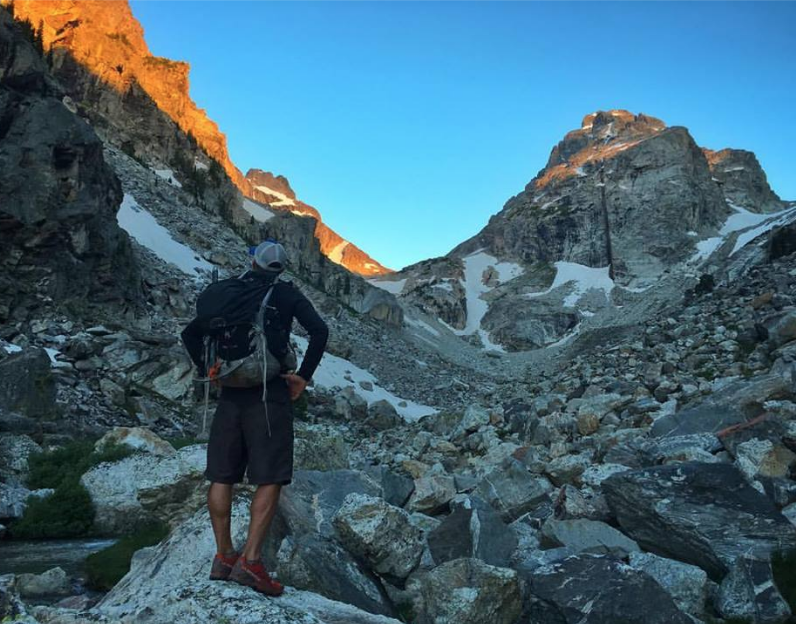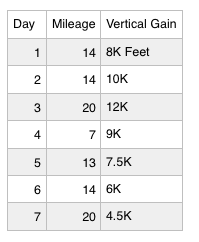
Photo by: Kelly Halpin
By Rob Shaul
In July 2016, Our Crux Award Winner, Ryan Burke, was 6 weeks away from his north to south skyline traverse of the entire Teton Range.
In this article, you will find how we approached this event to design an event-specific program.
Basic Trip Details
-
- 40 peaks
- 103 miles
- 114,000 vertical gain and loss (Approx 57,000 vertical gain)
- 82% off trail
- Trip includes scrambling from Class 3 to 5.8
- 7 day Trip
- 40 peaks
Here is Ryan’s mileage/elevation gain breakdown by day

Program Design Concerns – and Answers
1) How to design for a multi-stage event?
Ryan’s traverse won’t be a long, single push, but rather a stage event over 7 days. For a long single push, the athlete doesn’t need to perform the day after – he’s completed the event. But for a stage event, we must both be concerned about him completing the daily and cumulative volume, but also being able to recover between long days for the next day’s work. Our answer was to look at volume-based the entire traverse (102 miles, 57K vertical gain) and use weekly totals as our basis for the progression. The plan progresses (increases) mileage and vertical gain weekly through week 5, culminating in approximately 75% of the trip’s actual total – 76 miles, 43K vertical gain.
To prepare him for back to back hard days, we backloaded the weekly mileage and vertical gain to Saturday and Sunday. These two days would account for 50% of his weekly mileage and vertical gain. Saturday’s are the long days – and alone account for 30%
2) How to account for the impact of downhill movement and loading?
There’s a balance in most event-specific program design between preparing the athlete adequately for the event, but not injuring him/her in the process. Many of the events we program for (military selections, alpine climbs, etc.) are by their nature, very intense and extreme. In this case, Ryan’s primary issue with impact would be downhill running during his traverse, and his during his training sessions. How could we ensure he could handle the specific demands of his traverse, but not injure him to get there?
We deployed three tactics to train, but decrease impact.
First, we limited his max weekly mileage and vertical gain/loss to 75% of the trip total. We’re hoping 75% will meet the sweet spot between training him for the event, and keeping him healthy along the way.
Second, during his train up, we limited the time Ryan will carry a pack.
The vertical gain of the traverse is 57,000 vertical feet (which also means another 57,000 vertical feet downhill). Each step of the traverse, Ryan will carry a 20# pack. During the train up, however, we limit Ryan’s loaded movement to 50% of this weekly mileage and vertical gain – and to just Saturdays and Sundays.
Third, during his training week, Ryan’s only gym day is Tuesday, where we’ve got him doing 5,000 vertical feet on a versa climber. Our hope this will help condition him for the steep scrambling he’ll do, as well conditioning him for uphill movement. Versa climber work isn’t the same as loaded, uphill hiking, we know, so even though he does 5,000 versa climber feet, we’re only counting it as 3,000 vertical feet for his weekly total.
3) What about Mini-Events?
Ryan helped us here. He needed to do 3 scouting trips prior to his traverse attempt – to learn the route. From him, we learned the mileage and vertical gain/loss of these trips and worked them into the weekly totals. As well, his scouting trips will allow us to test the programming, his recovery, equipment, and nutrition, as we continue to get those dialed prior to the real thing.
Below is the outline of his training plan.

Questions, Comments, Feedback? Email rob@mtntactical.com
You Might Also Like Teton Grand Traverse Training Plan
